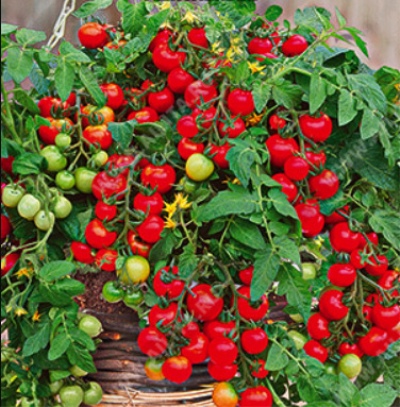
- Authors: Nastenko N.V., Kachainik V.G., Kandoba A.V. (Agrofirma Aelita LLC)
- Year of approval: 2008
- Category: grade
- Growth type: determinant
- Appointment: fresh consumption, for pickling and canning, for whole-fruit canning
- Ripening period: ultra early
- Ripening time, days: 75-80
- Growing conditions: for open ground, for film greenhouses, decorative landscaping
- Transportability: high
- Bush size: undersized
Ladybug is a determinant tomato variety familiar to many summer residents. The variety is popular in that it not only gives a rich harvest, but also looks beautiful, decorating the garden. However, these are not all of its strengths.
Breeding history
The variety has been used by gardeners since 2008. Such a variety of tomatoes was developed at Agrofirma Aelita LLC. Breeding works were carried out by N.V. Nastenko, V.G. Kachainik, A.V. Kandoba.
Description of the variety
The ladybug is not very tall, here it is only 30-50 centimeters. The plant is decorative, therefore it is often used for landscaping and ennobling the site. Compact bushes can grow both outdoors and in film greenhouses. The plants are covered with small green leaves. Ladybug belongs to the ampelous varieties.
The main qualities of the fruit
Ladybug bears fruit in small tomatoes, whose weight is only 20-25 grams. Ripe red fruits hang on the plant with tassels, however, the ripening is uneven, so most often on one bush you can see tomatoes of three colors at once: light green, red and almost burgundy. This gives the ladybug a decorative look.
Round berries of the variety are covered with a dense and smooth skin. It does not tend to crack, but many gardeners complain that the peel is even too thick.
Taste characteristics
Ladybug is a delicious tomato variety. Small and sweet fruits are remembered by everyone who has tasted them at least once. The sweetness is diluted with a slight sourness, so here we can talk about the harmony of taste.
The fruits obtained from the ladybug are very often used to decorate ready-made dishes. Their small size makes them also available for whole fruit canning.
Ripening and fruiting
Tomatoes of the Ladybug variety begin to ripen from the bottom. The attractive thing is that as fruiting, the berries do not shrink, remaining the same as in the first harvest. The ultra-early variety ripens in 75-80 days. Fruits are harvested for two months: July and August.
Yield
Tomatoes grown under the film give a good harvest - 9 kilograms per square meter. More than 3 kg of berries are obtained from the bush. It is worth noting that for such indicators, tomatoes need to be looked after. Plants stretch quickly, which causes only one brush to appear, rather than several. The fruits will weigh about 10 grams, naturally, the yield will be low.
The timing of planting seedlings and planting in the ground
The timing of planting seeds depends on the region where the gardener lives. So, in warm areas, sowing starts from the 20th of May. If the area is cool, you can move the dates back to April 10th. Containers for growing are taken from wood, their disinfection is a mandatory step. The soil is most often used purchased, it already has all the proportions. The basis of such land is peat. The containers must have holes and a drainage layer.
Seeds are treated with potassium permanganate before planting, dried. You can also use formulations that stimulate growth. The planted grains are provided with shelter and watering with warm water. At the right time, they do a dive. Do not forget about temperature indicators (minimum +18) and daylight hours (12 hours).Depending on the time of the initial sowing of the seeds, the seedlings are transferred to open ground from May 15 to June 5.

Growing tomato seedlings is an extremely important process, because it largely depends on whether the gardener can harvest at all. All aspects must be taken into account, from seedbed preparation to planting in the ground.
Landing scheme
The planted plants must receive a lot of oxygen and sufficient nutrients. Therefore, 1 sq. m, you can place no more than 5 ladybug bushes. The soil for planting should be loose and dug up, and the seedlings themselves are sprayed with copper oxychloride in advance. Tomatoes are planted in the soil according to the 50x40 centimeters scheme. This is immediately followed by abundant watering.

Growing and care
Initially planted seedlings will need to be shaded if they grow outdoors. Watering the first days is not needed. During the day, the plant will look frail, but by the evening the foliage will rise. If you keep the bushes in this way for several days, then they will learn how to independently extract water from the ground.
Further care will be easy, here are its main points:
the duration of daylight hours must be at least 12 hours;
plants are watered once a week with warm water, but drip irrigation will show itself best of all;
the bushes will definitely require a garter, since there are a lot of fruits, and the brushes are heavy;
once every 10 days in the morning, stepchildren are removed from tomatoes;
the soil needs to be loosened a few hours after watering, weeds removed from it, mulched again;
top dressing should contain a large amount of phosphorus.
The main mistakes when caring for a ladybug:
ensuring the temperature is below +18 degrees;
the use of fertilizing with a large amount of nitrogen;
growing on dense soil with high acidity;
untimely removal of stepchildren, leading to density and fungi.




A plant needs different micronutrients at each stage of growth. All fertilizers can be divided into two groups: mineral and organic. Folk remedies are often used: iodine, yeast, bird droppings, eggshells.
It is important to observe the rate and period of feeding. This also applies to folk remedies and organic fertilizers.



























































































